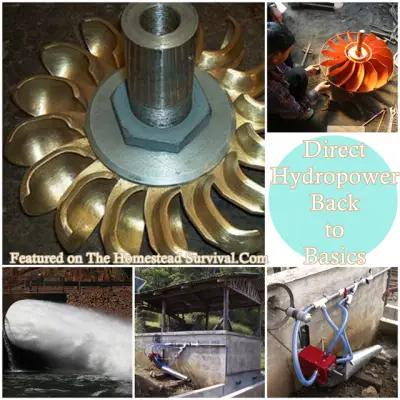Here is a look into direct hydropower, back to the basics of how people can use it to reduce labor and create power.
All hydropower plants produce electricity and it would probably seem that transforming energy to electricity is the only way to harness water power; however it’s not. For 2000 years water wheels powered machines directly via mechanical transmission.

There are now some small direct hydro powered systems in Southern America that present a strong case saying we should go back to those days. By combining the use of modern materials and old fashioned methods we could be more efficient. The higher efficiency of this approach would mean that less water is needed to produce a given amount of energy. This lowers the cost of hydropower and enables power to be produced by the use of very small streams.
Here’s why we should go back – modern hydro power is just not as efficient as direct hydro power. In spite of improvements hydro power installations are less efficient than those from earlier centuries. The culprit causing this; electricity. Instead of using water powered prime movers to run machinery directly, water turbines are used to produce electricity. This modern approach has introduced an energy deficit that has nullified any progress behind hydropower design efficiency.
In modern installation a water turbine converts the energy in the moving water into rotational energy at its shaft, which is then converted back into rotational energy by the electrical motor of the machine that is being powered. Every energy conversion introduces energy loss due to friction which is observable as heat, vibration and noise. Friction occurs at all levels of electrical transmission: turbine, generator and motor. Additional components such as batteries, drive systems and inverters can further increase efficiency losses.
It is possible to calculate efficiency ratings for each modern hydro powered unit by measuring the difference between turbine input and electric generator output. A home sized hydropower plant generating AC electric power has a water to wire energy transfer of at best 60-70%. Smaller DC electric systems which require inverters and generally have battery banks have lower efficiencies of 40-60%. On average a hydroelectric power installation only converts about ½ of the energy available in water into useful work.
This means a small modern hydropower plant has a similar efficiency rating to a century’s old configuration. Old fashioned hydro power using only one conversion of energy is the way to go. Important advantages of this are that more power can be gathered and utilized; this increases the energy production. It also means that because of higher efficiency direct hydro power is less expensive. The less water needed equates to reduced size, cost and other resources. Higher efficiency also limits the ecological impact of a power site. Maintaining enough water for aquatic life to thrive is a cornerstone of environmentally sound micro hydro power production.
Click here to read about
.Direct Hydropower Back to Basics

